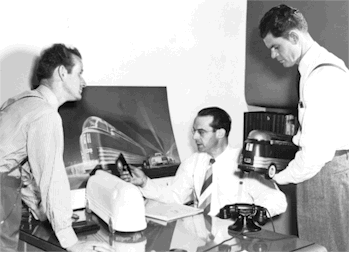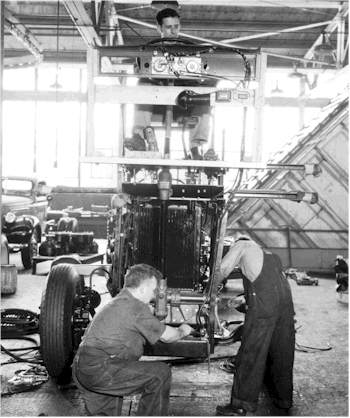 FUTURLINER FUTURLINER
DESIGN
The man behind the desk is Robert E.
Bingman, credited with designing the project in GM's Industrial Design
department. The men are reviewing the model design against the artist's concept drawing. Note
that because of the bubble canopy (designed by Raymond Smith) over the driver, this is the
"first edition" of the Futurliner. In the "second
edition" the canopy was designed out because of how hot the
drivers got. |
 FUTURLINER
FUTURLINER
CONSTRUCTION
This photo shows some very preliminary
assembly of a Futurliner. A notation on the back of the 1940 photo says
"Yellow Truck, Pontiac, Michigan."
The red and white
Futurliners were one of the leading attractions of the Parade of
Progress. The Futurliners were built by the GMC Truck & Coach
Division and the Fisher Body Division in cooperation with the GM Styling
Section and the GM Research Laboratories Division.
They were 33 feet long, 8 feet wide and 11 feet 4
inches high. The wheelbase was 248 inches and the frame, 32 feet long.
Conventional cross bars were used to strengthen the frame. Outriggers
were attached to the main frame to hold the body.
The driver's compartment bears some resemblance to an
airplane cockpit of the period. It was entered through a door at the
right front of the vehicle. A stairway leads up to the compartment,
which sits high above the wheels.
The driver's eyes are 10 feet above road level. He
has a single seat which is located at the front center of the
compartment. Behind him are twin relief seats for assistances or special
guests.
The compartment is kept at a comfortable temperature
by a Frigidaire air conditioner similar to what was available on some
1953 GM passenger cars. Upholstery of the compartment is of vinyl coated
fabric in two-tone lime and hunter green. The windshield curves almost
completely around the compartment and was of green-tinted E-Z Eye glass.
Futurliner windshields were the largest E-Z Eye installations ever made
up until that time. Futurliners were equipped with the Guide Lamp Division's
Autronic-Eye, which automatically lowered the headlight beams when
another vehicle approached, then raises the lights again.
Power Steering was developed by the Saginaw Steering
Gear Division. The steering wheel is mounted on a streamlined column at
the front center of the compartment. Foot pedals for the brake and
accelerator are treadle type with corrugated rubber treads, set off by
chrome plates. There was no clutch. Transmissions are Dual-Range Hydra-Matic
manufactured by the Detroit Transmission Division.
Each Futurliner was powered by a 145 horsepower, 302
cubic inch GMC gasoline engine, which is located directly under the
driver's compartment. Compression ration is 7.3 to 1. Bore and stroke
are each 4 inches. They produced 262 foot pounds of torque at 1,400
revolutions per minute. The engine is reached for servicing by a large
door which is located at the left front of the vehicle. There are two
gasoline tanks, each holding 45 gallons, located in front of the rear
wheels.
Safety features include dual front wheels which
increase roadability and safety rubber covered bumpers give the steel
bumpers added protection and rubber rail runs around the base of the
body. Other special equipment for the Futurliners include large
power-operated side doors which swing upward to reveal enclosed exhibits
and steel lighting towers.
Note that the dual front wheels were not a new invention. We
have a photo of an all-wheel drive Ford equipped with dual front wheels
by the Differential Wheel Corp. Each wheel rotates separately.
|
 FUTURLINER
FUTURLINER FUTURLINER
FUTURLINER